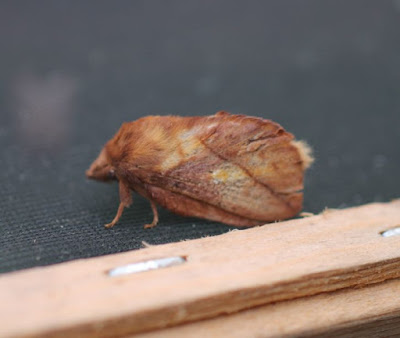 |
| Chinese Character (Cilix glaucata) |
The Chinese Character (Cilix glaucata) can usually be found tucked into a space that it seems to create all for itself. Whilst the Mother of Pearls, the Underwings and the Elephant Hawk-moths are whirring around, this bluish-grey (glaucus) little moth remains serene and undisturbed imitating a bird-dropping. The cilix part of its scientific name refers to Cilicia, a coastal region of SE Asia to the north of Cyprus.
 |
| Broad-bordered Yellow Underwing (Noctua fimbriata) |
The Broad-bordered Yellow Underwing (Noctua fimbriata) is one of those moths that can disturb everything and everybody when it gains access through the open window late at night, cannoning and catapulting itself crazily around the room. Its flight is rapid and vigorous and it can easily be disturbed by day from wherever it has chosen to rest.
Beautifully marked, the moth appears in a number of colours - the one above seemed less brown and more steely-blue when I photographed it, but the markings are consistent. Nettles primrose and dock are the food sources for the caterpillar and the adult is much loved by bats - the brightly coloured underwings being the evidence that remains after the bat has made its meal.
 |
| Drinker (Euthrix potatoria) |
The-sipper-of-dew, the lover-of-water could be alternative names for the Drinker moth (Euthrix potatoria) that appears regularly as July comes to a close. A member of the group of moths known as the Eggars. These moths tend to be thickly set and quite large and can be mistaken for tiny birds as the moths also fly during the day. They do not feed in the adult state and the caterpillars provide a vital source of food for the increasingly scarce Cuckoo (Cuculus canorus) that is not deterred by the bristle-haired larvae.
No new species found in the gardens for quite some time but at least the numbers of moths attracted to the mercury vapour light seem to be healthier than earlier in the year.
